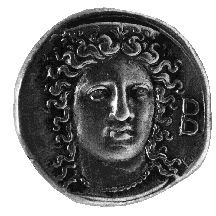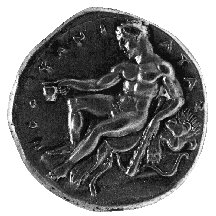



(5) Kroton, Bruttium (Italy) - AR stater, c. 360 B.C., 7.78 g.
(inv. 91.018).
Obverse: Facing head of Hera, wearing necklace and stephane
with palmettes; in r. field, B.
Reverse: Herakles seated on lionskin, with cup in r. and club in
l., bow lying at his side; ![]() : Krotoniate.
: Krotoniate.
Provenance: Münzen und Medaillen, 1986.
Bibliography: R.R. Holloway, Art and Coinage in Magna Graecia
(Bellinzona n.d.); C.M. Kraay, Archaic and Classical Greek Coins
(Berkeley and Los Angeles 1976).
Kroton was a prosperous city in southern Italy, famous in antiquity for
its athletes, doctors and philosophers. The city was founded by the Achaeans
in the late eighth century on the instructions of the oracle of Apollo at
Delphi, but legend credits the hero Herakles with its foundation.
The reverse of this coin refers to the city's foundation by Herakles. The
nude hero reclines on his lionskin, with his club held lightly in his left
hand, while he raises his drinking cup in his outstretched right hand. The
figure with its finely detailed musculature resembles the figure sometimes
identified as Herakles in the east pediment of the Parthenon in Athens.
On the obverse is the head of Hera, whose sanctuary of Hera Lacinia was
located on a promontory of Cape Colonna some six miles from Kroton. The
richly decorated temple there was supposedly constructed by Herakles. The
head on the coin was probably influenced by Kimon's famous facing head of
the nymph Arethusa on the late fifth-century coins of Syracuse (see no.
17).
C.L.L.



All contents copyright (c) 1996.
Lawrence University
All rights reserved.